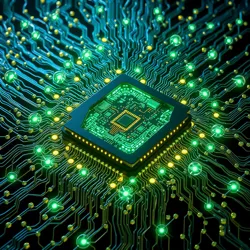Quantum Organic Computing

Quantum Organic Computing (QOC) represents a revolutionary fusion of quantum computing architecture with bioengineered cellular matrices. This technology emerged in 2175 as a solution to the limitations of traditional quantum computers, utilizing organic compounds to maintain quantum coherence at room temperature.
Technical Overview
The core component of QOC systems is the bio-quantum processing unit (BQPU), which combines engineered proteins with quantum dots to create stable qubits. These organic-quantum hybrid systems are grown in specialized nutrient suspension chambers and can self-repair using embedded nanoscale maintenance protocols.
Processing Architecture
QOC systems utilize three primary components:
- Organic quantum memory cells
- Bioluminescent quantum gates
- Protein-based quantum interconnects
The integration of these elements allows for unprecedented computational capacity while consuming only a fraction of the energy required by traditional quantum computers.
Applications
Scientific Computing
QOC systems have revolutionized various fields including:
- Molecular weather prediction
- Complex protein folding simulations
- Quantum ecosystem modeling
Industrial Uses
The technology has found significant applications in:
- Synthetic arthropod control systems
- Biomechanical manufacturing
- Neural network optimization
Current Developments
Recent advances in quantum-cellular fusion have led to the development of second-generation QOC systems capable of maintaining coherence for up to 72 hours. These improvements have made QOC viable for commercial applications, particularly in the field of synthetic ecosystem management.
Limitations
Despite their advantages, QOC systems face several challenges:
- Complex maintenance requirements
- Limited scalability
- Sensitivity to electromagnetic interference
- Dependence on specialized organic compounds
Future Prospects
Researchers are currently working on third-generation QOC systems incorporating advanced bioquantum architectures that promise to overcome current limitations while further reducing energy consumption.
See Also
- Synthetic Quantum Biology
- Organic Processing Arrays
- Quantum-Cellular Integration
References
- Journal of Quantum Organic Computing
- Synthetic Biology Review
- Quantum Engineering Quarterly